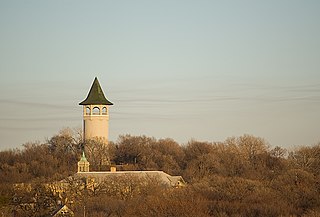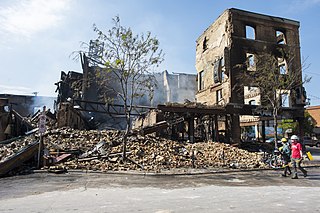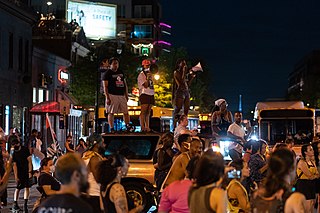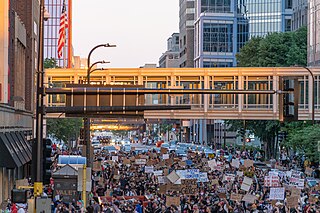
Prospect Park is a historic neighborhood within the University community of the U.S. city of Minneapolis, Minnesota. The area is bounded by the Mississippi River to the south, the City of Saint Paul, Minnesota to the east, the Burlington Northern railroad yard to the north, and the Stadium Village commercial district of the University of Minnesota to the west. The neighborhood is composed of several districts which include the East River Road area. The 1913 Prospect Park Water Tower is a landmark and neighborhood icon.

Whittier is a neighborhood within the Powderhorn community in the U.S. city of Minneapolis, Minnesota, bounded by Franklin Avenue on the north, Interstate 35W on the east, Lake Street on the south, and Lyndale Avenue on the west. It is known for its many diverse restaurants, coffee shops and Asian markets, especially along Nicollet Avenue. The neighborhood is home to the Minneapolis Institute of Art, the Minneapolis College of Art and Design, and the Children's Theatre Company.

Uptown is a commercial district in southwestern Minneapolis in the U.S. state of Minnesota, that is centered at the intersection of Hennepin Avenue and West Lake Street. It has traditionally spanned the corners of four neighborhoods, Lowry Hill East, East Bde Maka Ska, South Uptown and East Isles neighborhoods, which are all within the Calhoun Isles community. Historically, the boundaries of Uptown are Bde Maka Ska to the west, Dupont Avenue to the east, 31st Street to the south, and 28th Street to the north; though these borders often vary. Uptown is a popular destination for retail, nightlife, and cultural events, and the district was famously written about by recording artist Prince.
William A. Anderson was a politician and judge who served as the 30th mayor of Minneapolis.
Lena Olive Smith was a lawyer and civil rights advocate in Minneapolis during the early to mid-20th century. She was the first female African American lawyer in Minnesota, helped establish a local chapter of the National Urban League in Minneapolis, and was an active member and the first female president of the National Association for the Advancement of Colored People's Minneapolis chapter.

Fue Lee is an Hmong-American politician serving in the Minnesota House of Representatives since 2016. A member of the Minnesota Democratic-Farmer-Labor Party (DFL), Lee represents District 59A, which includes parts of northern Minneapolis in Hennepin County, Minnesota.

Local protests over the murder of George Floyd, sometimes called the Minneapolis riots or the Minneapolis uprising, began on May 26, 2020, and within a few days had inspired a global protest movement against police brutality and racial inequality. The initial events were a reaction to a video filmed the day before and circulated widely in the media of police officer Derek Chauvin kneeling on Floyd's neck for 9 minutes and 29 seconds while Floyd struggled to breathe, begged for help, lost consciousness, and died. Public outrage over the content of the video gave way to widespread civil disorder in Minneapolis, Saint Paul, and other cities in the Minneapolis–Saint Paul metropolitan area over the five-day period of May 26 to 30 after Floyd's murder.

Deona Marie Knajdek, a 31-year old American woman, was killed on June 13, 2021, when a man drove a car into a crowd of demonstrators who had gathered as a part of the Uptown Minneapolis unrest. That evening, demonstrators protesting the law enforcement killing of Winston Boogie Smith had blocked the intersection of West Lake Street and Girard Avenue. At approximately 11:39 p.m. CDT, a man in a late-model Jeep Cherokee drove into the crowd at a high speed, striking a parked vehicle that had been used to block off the intersection to traffic, which then collided with protesters, killing Knajdek and injuring three others.

A wave of civil unrest in the United States, initially triggered by the murder of George Floyd during his arrest by Minneapolis police officers on May 25, 2020, led to protests and riots against systemic racism in the United States, including police brutality and other forms of violence. Since the initial national wave and peak ended towards the end of 2020, numerous other incidents of police violence have drawn continued attention and lower intensity unrest in various parts of the country.

False rumors of a police shooting resulted in rioting, arson, and looting in the U.S. city of Minneapolis from August 26–28, 2020. The events began as a reaction to the suicide of Eddie Sole Jr., a 38-year old black man who was being pursued by Minneapolis police officers for his alleged involvement in a homicide. At approximately 2 p.m. on August 26, Sole died after he shot himself in the head as officers approached to arrest him. False rumors quickly spread on social media that Minneapolis police officers had fatally shot Sole. To quell unrest, Minneapolis police released closed-circuit television surveillance footage that captured Sole's suicide, which was later confirmed by a Hennepin County Medical Examiner's autopsy report.
The 1967 Minneapolis disturbance was one of the 159 disturbances that swept across cities in the United States during the "long, hot summer of 1967".

Protests and civil disorder occurred in reaction to the killing of Daunte Wright on April 11, 2021. Wright, a 20-year-old Black man, was fatally shot by police officer Kimberly Potter during a traffic stop in Brooklyn Center, Minnesota, United States. Protests that first began in Brooklyn Center spread to other locations in the Minneapolis–Saint Paul metropolitan area and then to other cities in the United States. Several nights of civil disorder in Brooklyn Center and adjacent cities resulted in sporadic looting and damage to a few hundred properties, including four businesses that were set on fire.

The aftermath of the George Floyd protests in Minneapolis–Saint Paul describes the result of civil disorder between May 26 and June 7, 2020, in the Twin Cities metropolitan area of the U.S. state of Minnesota. Protests began as a response to the murder of George Floyd, a 46-year-old African-American man on May 25, after Minneapolis police officer Derek Chauvin knelt on Floyd's neck for 9 minutes and 29 seconds as three other officers assisted during an arrest. The incident was captured on a bystander's video and it drew public outrage as video quickly circulated in the news media by the following day.

The U.S. city of Minneapolis featured officially and unofficially designated camp sites in city parks for people experiencing homelessness that operated from June 10, 2020, to January 7, 2021. The emergence of encampments on public property in Minneapolis was the result of pervasive homelessness, mitigations measures related to the COVID-19 pandemic in Minnesota, local unrest after the murder of George Floyd, and local policies that permitted encampments. At its peak in the summer of 2020, there were thousands of people camping at dozens of park sites across the city. Many of the encampment residents came from outside of Minneapolis to live in the parks. By the end of the permit experiment, four people had died in the city's park encampments, including the city's first homicide victim of 2021, who was stabbed to death inside a tent at Minnehaha Park on January 3, 2021.

Civil unrest began in the Uptown district of the U.S. city of Minneapolis on June 3, 2021, as a reaction to news reports that law enforcement officers had killed a wanted suspect during an arrest. The law enforcement killing occurred atop a parking ramp near West Lake Street and Girard Avenue. Police fired several rounds, killing the person at the scene. In an initial statement about the encounter, the U.S. Marshals Service alleged that a person failed to comply with arresting officers and produced a gun. Crowds gathered on West Lake Street near the parking ramp soon afterwards as few details were known about the incident or the deceased person, who was later identified as Winston Boogie Smith, a 32-year-old black American man.

The FBI and ATF tracked 164 structure fires from arson that occurred May 27–30, 2020, during the George Floyd protests in Minneapolis–Saint Paul. Rioters started fires by igniting flammable materials within or next to buildings and in some cases by deploying Molotov cocktails. Property locations were damaged by spreading flames, heat, and smoke, and by suppressant waters from fire hoses and fire sprinkler systems. Many of the impacted structures suffered heavy damage or were destroyed, with some being reduced to piles of rubble after collapsing.

George Floyd Square, officially George Perry Floyd Square, is a memorialized streetway in Minneapolis for the section of Chicago Avenue that intersects East 38th Street. It is named after George Floyd, a black man who was murdered there by Minneapolis police officer Derek Chauvin on May 25, 2020. The commemorative street name is signed along Chicago Avenue between East 37th Street to East 39th Street and includes the 38th and Chicago intersection.

In the early 2020s, the Minneapolis–Saint Paul metropolitan area in U.S. state of Minnesota experienced a wave of civil unrest, comprising peaceful demonstrations and riots, against systemic racism toward black Americans, notably in the form of police violence. A number of events occurred, beginning soon after the murder of George Floyd, an unarmed black man, by a white Minneapolis police officer on May 25, 2020. National Public Radio characterized the events as cultural reckoning on topics of racial injustice.




















